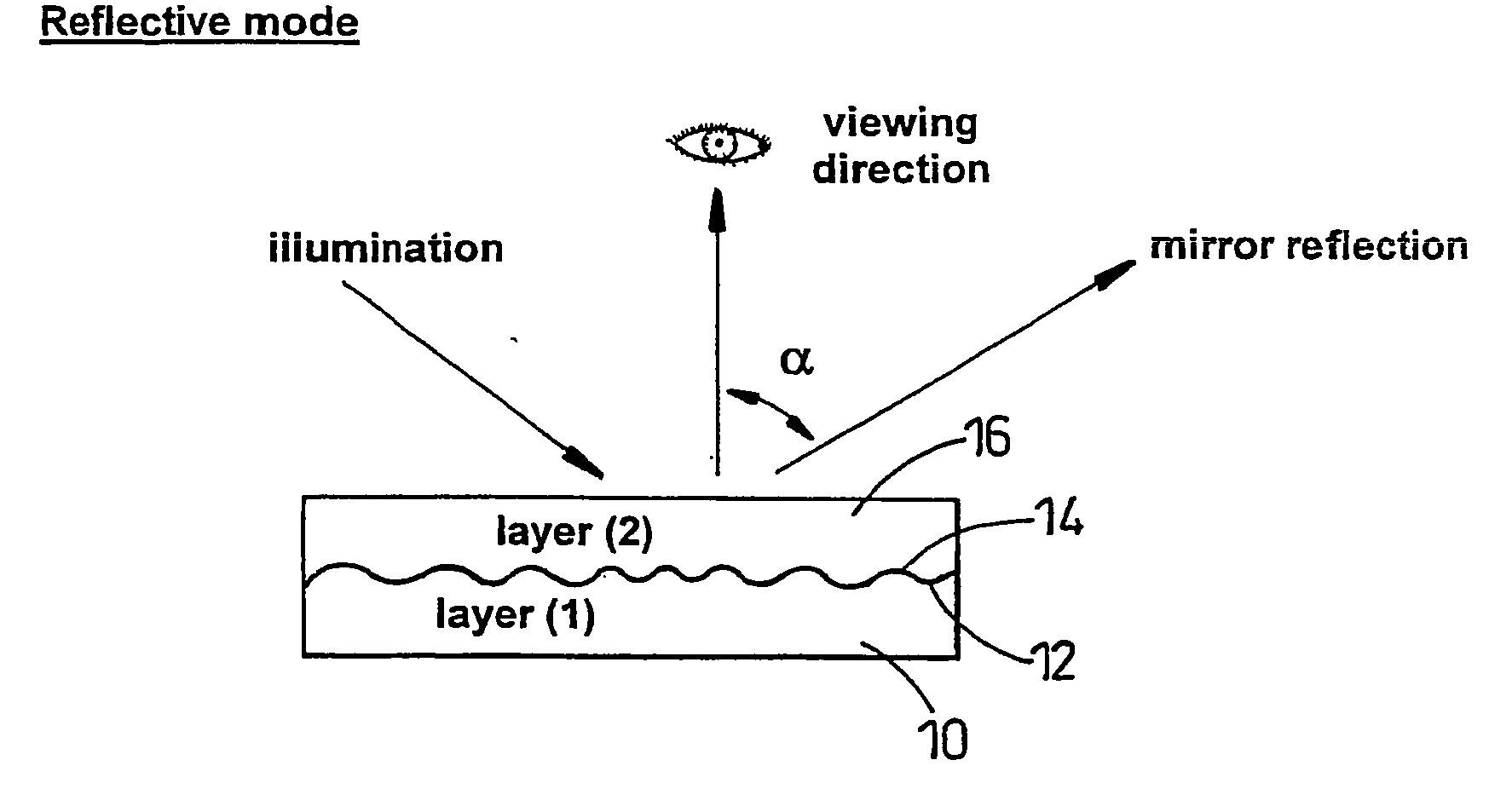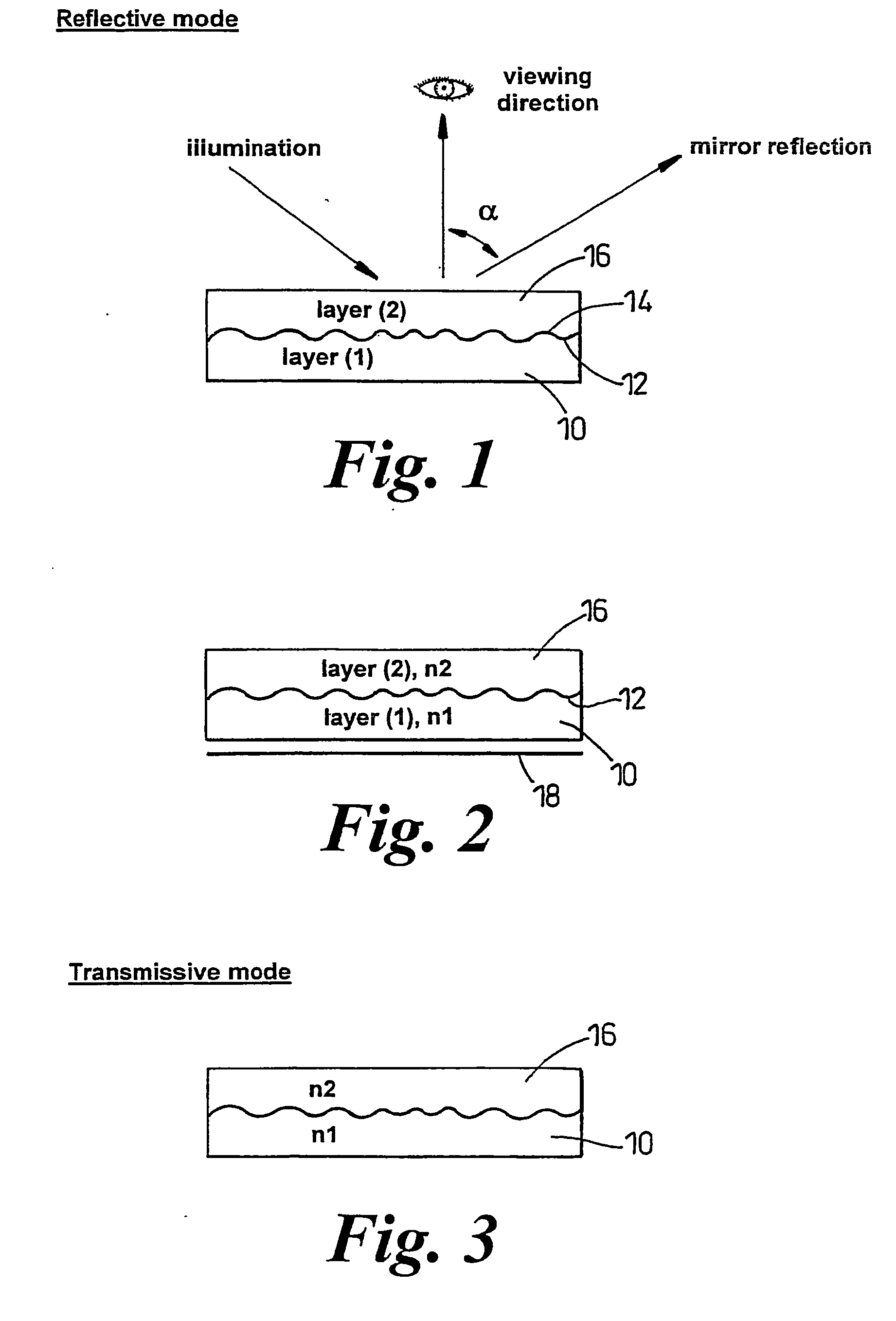Diffractive, polarization modulating optical devices
a technology of polarization modulation and optical devices, applied in the field of optical devices, can solve the problems of compromising integrity and less suitable for volume low cost manufacturing, and achieve the effect of little or no diffractive
- Summary
- Abstract
- Description
- Claims
- Application Information
AI Technical Summary
Benefits of technology
Problems solved by technology
Method used
Image
Examples
first embodiment
[0088] Referring to FIG. 4, in this embodiment, the whole area of the device acts both to apply a diffractive effect (type A) to produce a first image and a phase modulation / retardation (type B) to produce a second image.
[0089] In this case the relief structure (p, D) is similar to that described in that of the previously described grating design for a Type A diffractive security optical device. In this embodiment the polymerisable liquid crystal material is RMM34 (from Merck) but other similar types are available. This material has extraordinary and ordinary refractive indices ne=1.68 and no=1.525, giving Δn=0.155.
[0090] The optical retardation δ is given by δ=2d (ne−no), the factor 2 being because the device is used in reflective mode. d is the thickness of the optically anisotropic layer.
[0091] For λ=0.5 μm for average visible light, this gives:
d=0.8065 μm for (½λ plate)
d=0.4032 μm for (¼λ plate)
[0092] It is known that a ½λ retardation alters the direction of polarization o...
second embodiment
[0098] In this embodiment illustrated in FIG. 6, the device is constructed to be viewed in transmission mode. The layer 20 is isotropic but transparent and carries a micro-relief diffractive structure 22 which serves also to align the anisotropic liquid crystal material layer 26.
[0099] In this case the retardation is given by δ=(ne−no).d, and so for ½λ requires d=1.613 μm (λ=0.5 μm).
[0100] In a variation of embodiment, the interface may be only partly coated with a reflective layer, with the remainder being transmissive so that the device operates as ½λ plate in transmission and a full λ plate in reflection (e.g. no retardation). Accordingly, in this variation a thickness d=0.8065 μm may be selected to give operation of ¼λ in transmissive mode and operation of ½λ in reflective mode.
third embodiment
[0101] In this embodiment, all or part of the optical device is constructed so that, although the substrate carries a micro-relief grating structure, its diffractive properties are minimal or negligible. Referring to Equation (1) it will be seen that if p (pitch of the grating) is small (e.g. p=0.2 or 0.1 μm or less) then all the diffractive orders are suppressed. Furthermore, if the depth of the structure is very small, e.g. D˜0.05 μm or less, then it is known from diffraction theory that the diffraction efficiency of the grating will be very low, in fact very little light is diffracted. However with these parameters (e.g. p˜0.1 μm, D˜0.05 μm) it should be emphasised that alignment will continue to occur quite efficiently, and this regime may be termed “alignment only”. In this regime the grating parameters for p or D are as above. In practice the device will diffract poorly if either of the parameters is in this regime and certainly does so if both are of the same regime.
[0102] T...
PUM
 Login to View More
Login to View More Abstract
Description
Claims
Application Information
 Login to View More
Login to View More - R&D
- Intellectual Property
- Life Sciences
- Materials
- Tech Scout
- Unparalleled Data Quality
- Higher Quality Content
- 60% Fewer Hallucinations
Browse by: Latest US Patents, China's latest patents, Technical Efficacy Thesaurus, Application Domain, Technology Topic, Popular Technical Reports.
© 2025 PatSnap. All rights reserved.Legal|Privacy policy|Modern Slavery Act Transparency Statement|Sitemap|About US| Contact US: help@patsnap.com



